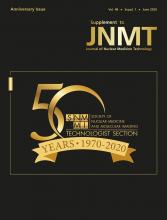Nuclear Medicine Technologists and Innovative Radiopharmaceuticals – A Blue Earth Diagnostics Case Study
Since its founding in 2014, Blue Earth Diagnostics has been committed to advancing PET technology and nuclear medicine in order to meet patient needs. Starting with just 4 employees and growing to more than 100 in only 6 years is a testament to the enthusiasm, expertise and commitment to developing new products in the molecular imaging industry.
In 2016, Blue Earth Diagnostics received approval from the U.S. Food and Drug Administration (FDA) for Axumin® (fluciclovine F 18) injection. Axumin is the first FDA-approved F 18 product for positron emission tomography (PET) in men with suspected prostate cancer recurrence based on elevated blood prostate specific antigen (PSA) levels following prior treatment. According to clinical studies, utilization of Axumin PET imaging results in a change in management for approximately 60% of men with recurrent prostate cancer, addressing a large unmet need.
The story of Axumin is quite incredible. Fluciclovine (originally known as FACBC) was developed at Emory University by Dr. Mark Goodman and colleagues in the 1990s, where it was first studied for the imaging of brain tumors. It was originally licensed to Nihon-MediPhysics and subsequently to GE Healthcare. The founders of Blue Earth Diagnostics, who then worked at GE Healthcare, realized the potential of the innovative technology and acquired the compound in 2014, with the goal of taking fluciclovine through the development process and ultimately to commercialization. Axumin was granted Priority Review by the FDA, approved in May, 2016, and patient scans began shortly thereafter. Since FDA approval, approximately 75,000 patients have had an Axumin scan for suspected prostate cancer recurrence.
Over the last three years, Blue Earth Diagnostics has been deeply committed to education and investing in the future of nuclear medicine. Imagers need to understand the protocols and interpretation techniques for Axumin PET imaging. To ensure that patients and their caregivers receive the best information possible, we have deployed a skilled team of nuclear medicine technologists to provide training on proper administration of Axumin and image acquisition. In addition, they help ensure that the interpreting physician has accessed the fluciclovine reader training available through SNMMI.
The nuclear medicine technologist at the imaging site plays an extremely important role in ensuring the quality of the scan, being the “face” the imaging center to the patient, and of course, in performing the scan itself. Patients with a history of prostate cancer and a suspected recurrence are often very nervous about the scan, sometimes referred to as “scanxiety,” and the nuclear medicine technologist is typically the person putting the patient at ease so they can complete the scan successfully. Nuclear medicine technologists need to perform their duties effectively and efficiently, while maintaining compassion for the patient and their caregivers. The interpreting physician usually interprets the scan completed by the nuclear medicine technologist; for an Axumin scan, the nuclear medicine technologist is responsible for following the proper acquisition protocol to optimize the image for interpretation. The technologist shares any protocol or other variations from the protocol with the referring physician, in case it should be considered or noted during the interpretation and reporting.
Blue Earth Diagnostics currently has seven highly-engaged nuclear medicine technologists employed in the United States. Four of these technologists comprise our Molecular Imaging Specialist team, which is responsible to ensure that all imaging centers are as prepared as possible to perform an Axumin scan. The team works directly with the imaging centers to provide initial acquisition and interpretation training. The team also has a technologist who supports the clinical development team, and one who is a Field Reimbursement Specialist who can address reimbursement and coverage questions.
Much of my experience as a technologist serves me well in my current day-to-day work, and it seems that the patient interactions remain with you long after you may have been active in scanning − there are certain patient scans I will never forget and often recall twenty years later. Examples might be, requesting an urgent read and phone follow up for patients with significant scans, or telling a patient who has not eaten for several hours and eager to get the scan that something went wrong at the pharmacy and that their scan will need to be rescheduled. These situations happen, and the nuclear medicine technologist is often on the front lines of juggling compassion, expertise and urgency.
Technologists are very important to the execution of any nuclear medicine procedure, and especially during this time of challenges around COVID-19, our sincere gratitude goes out to the imaging community and all healthcare workers. Blue Earth Diagnostics is proud to sponsor the 50th Anniversary of the Technologist Section.
Axumin® (fluciclovine F18) Injection Indication
Axumin injection is indicated for positron emission tomography (PET) imaging in men with suspected prostate cancer recurrence based on elevated blood prostate specific antigen (PSA) levels following prior treatment.
Axumin® (fluciclovine F18) Injection Important Safety Information
Image interpretation errors can occur with Axumin PET imaging. A negative image does not rule out recurrent prostate cancer and a positive image does not confirm its presence. The performance of Axumin seems to be affected by PSA levels. Axumin uptake may occur with other cancers and benign prostatic hypertrophy in primary prostate cancer. Clinical correlation, which may include histopathological evaluation, is recommended.
Hypersensitivity reactions, including anaphylaxis, may occur in patients who receive Axumin. Emergency resuscitation equipment and personnel should be immediately available.
Axumin use contributes to a patient’s overall long-term cumulative radiation exposure, which is associated with an increased risk of cancer. Safe handling practices should be used to minimize radiation exposure to the patient and health care providers.
Adverse reactions were reported in ≤1% of subjects during clinical studies with Axumin. The most common adverse reactions were injection site pain, injection site erythema and dysgeusia.
To report suspected adverse reactions to Axumin, call 1-855-AXUMIN1 (1-855-298-6461) or contact FDA at 1-800-FDA-1088 or www.fda.gov/medwatch.
Full Axumin prescribing information is available at: www.axumin.com.









